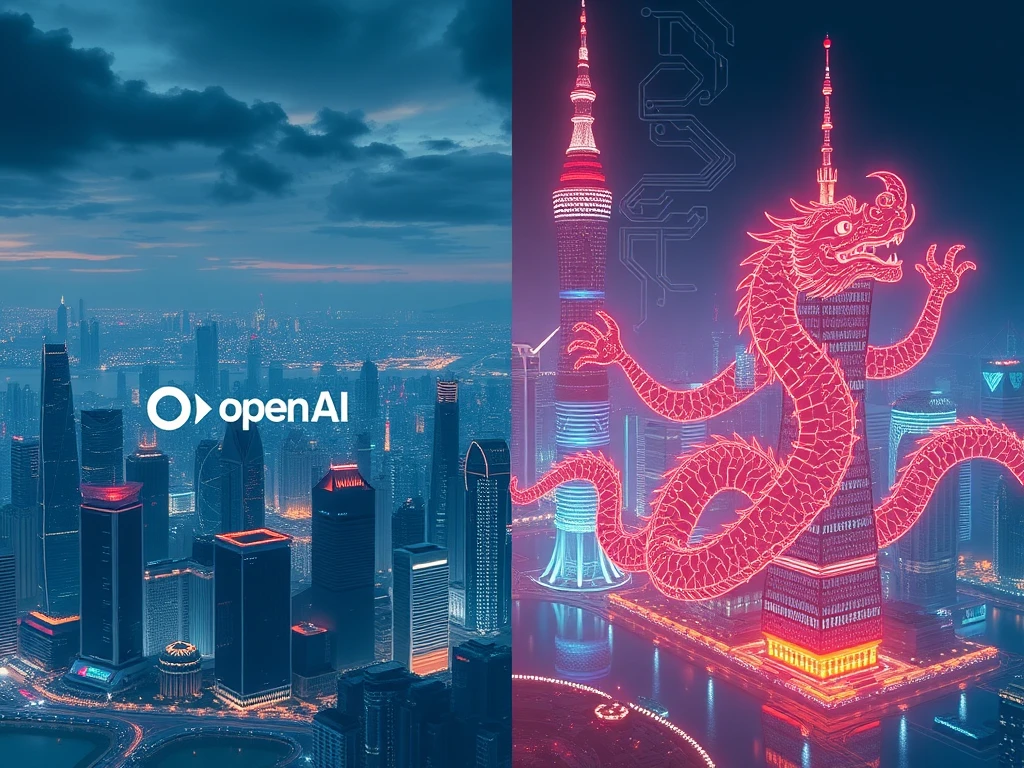Explosive OpenAI Revenue Growth Faces Fierce Chinese AI Competition

Hold onto your hats, crypto and tech enthusiasts! The AI race is heating up faster than a Bitcoin bull run, and the latest projections for OpenAI are nothing short of staggering. We’re diving deep into how OpenAI is eyeing a massive revenue surge while facing a formidable challenge from rapidly advancing Chinese AI firms. Is this the dawn of a new era in the AI market, or a battle for dominance?
Explosive OpenAI Revenue Growth Projected
Get ready for some eye-popping numbers. OpenAI, the powerhouse behind ChatGPT, is forecasting an absolutely explosive OpenAI revenue growth, anticipating a tripling of its income to a whopping $12.7 billion in 2025. And it doesn’t stop there – projections for 2026 are even more ambitious, aiming for $29.4 billion. This meteoric rise is fueled by the widespread adoption of its paid AI subscription services, proving that businesses and consumers are hungry for cutting-edge generative AI tools like ChatGPT.
Let’s break down the key drivers of this growth:
- Subscription Model Success: OpenAI’s paid subscription tiers, including ChatGPT Pro and enterprise versions, have clearly resonated with users. Hitting 1 million corporate subscribers last September underscores the strong demand.
- Continuous Innovation: The anticipation surrounding GPT-4.5 and GPT-5, with promises of enhanced intelligence and new features like voice and deep research capabilities, keeps users engaged and eager for upgrades.
- Strategic Funding: A potential $40 billion funding round led by SoftBank, valuing OpenAI at up to $300 billion, signals massive investor confidence and provides capital for further expansion and development.
However, this impressive trajectory isn’t without its challenges. While OpenAI is not expected to be cash-flow positive until 2029, the real pressure is coming from across the Pacific.
The Rise of Chinese AI Competition
While OpenAI dominates headlines in the West, a fierce Chinese AI competition is rapidly emerging. Companies like DeepSeek, Baidu, Alibaba, and Tencent are unleashing a wave of powerful and cost-effective AI models that are starting to rival, and in some cases, undercut their US counterparts. DeepSeek’s “R-1” model sent shockwaves through the industry, and it was quickly followed by Baidu’s “Ernie X1” and Alibaba’s open-source AI model. Even tech giants like Tencent are joining the fray with their own AI chatbots.
Here’s a snapshot of the key Chinese AI players and their moves:
| Company | AI Model/Initiative | Significance |
|---|---|---|
| DeepSeek | R-1, DeepSeek-V3-0324 | ChatGPT competitor, rapidly closing the gap with US models. |
| Baidu | Ernie X1 | Direct competitor to DeepSeek’s R-1 in China. |
| Alibaba | Open-source AI model | Focus on cost-effective AI agents, democratizing access. |
| Tencent (Ant Group) | AI Chatbot | Expanding AI capabilities within its vast ecosystem. |
ChatGPT Rivals Emerge as Serious Contenders
The question on everyone’s mind: how do these ChatGPT rivals stack up against OpenAI? While direct comparisons are still emerging, industry experts suggest the Chinese AI models are rapidly catching up in terms of quality and are often offered at more competitive prices. Lee Kai-fu, CEO of 01.AI, estimates that Chinese AI firms are now only about three months behind their US counterparts, a significant leap from being six to nine months behind previously.
This narrowing gap is putting pressure on US AI companies. Balaji Srinivasan, a prominent tech investor, points out that China’s strategy mirrors their playbook in other industries: study, copy, optimize, and then dominate with lower prices and massive scale. This competitive pricing strategy could significantly impact the business models of leading US AI firms.
Navigating the Competitive AI Market
The AI market is becoming a global battleground. For investors and businesses, understanding this evolving landscape is crucial. Here are some key takeaways:
- Increased Competition Benefits Consumers: The rise of multiple high-quality AI models, especially from China, is likely to drive down prices and accelerate innovation, ultimately benefiting users.
- Focus on Specialization and Differentiation: To maintain a competitive edge, US AI companies may need to focus on specialization, niche applications, or areas where they can truly differentiate themselves beyond just price.
- Geopolitical Implications: The AI race is intertwined with geopolitical dynamics. The US and China are vying for leadership in this critical technology, which has implications for economic power and national security.
- Ethical and Regulatory Considerations: As AI becomes more powerful and pervasive, ethical considerations and regulatory frameworks will become increasingly important, adding another layer of complexity to the market.
The Generative AI Future: A Two-Horse Race?
The future of generative AI is shaping up to be incredibly dynamic. While OpenAI is currently leading the charge with its impressive revenue growth and groundbreaking models, the rapid ascent of Chinese AI firms cannot be ignored. Whether it becomes a two-horse race or a more multi-polar competition remains to be seen, but one thing is certain: the pace of innovation in AI is only going to accelerate. Keep watching this space – it’s going to be a thrilling ride!









